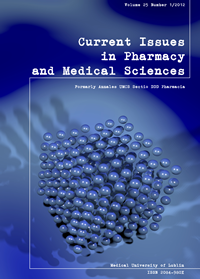Assessment of using additional means of oral hygiene on the state of the hard tissue of teeth in 12-13 year old children living in the Lublin province
DOI:
https://doi.org/10.12923/j.2084-980X/25.1/a.10Słowa kluczowe:
additional means of oral hygiene, children, dental cariesAbstrakt
The impact of additional means of oral hygiene (rinses, dental floss, dental irrigators, toothpicks) on the state of the hard tissue of teeth was assessed in 12-13 year old children living in the Lublin province. In order to accomplish this, clinical trials were conducted on 262 school-students aged 12-13 years from the Lublin macro-region. The study was conducted in randomly chosen primary schools, using standard clinical studies and surveys. The average number of DMFS, including its individual components D,M,F was determined. In addition, the authors also determined the OHIS index and DIS and CIS. Statistical analysis showed significant differences in the Oral Health Information Suite index (OHIS) between people who took additional measures in keeping oral hygiene, in comparison to those who did not (p=0.04). However, there were no statistically significant differences in the number of DMFS (including its individual components D,M,F), DIS, CIS and CPITN in children who declared using additional means of oral hygiene, as opposed to their peers who only brushed their teeth. The conducted studies showed the significant impact of using additional means of oral hygiene on the amount of plaque (OHIS index) among children.
Bibliografia
1. Longwell J.: The fluoridation of public water supplies: Chemical and technical aspects. R. Soc. Health J., 1957, 77, 361-370.
2. Milsom K., Woodward M., et al.: Enamel Defects in the Deciduous Dentition as a Potential Predictor of Defects in the Permanent Dentition of 8- and 9-year-old Children in Fluoridated Cheshire. England. J. Dent. Res., 1996, 75 (4), 1015-1018.
3. Pajdowski L.: Chemia ogólna. PWN, Warszawa 2002, 419-430.
4. Baryłko-Piekielna, N. and Drabent Z.: Zarys analizy sensorycznej żywności. WNT, Warszawa 1975, 149-150.
5. Wysokińska-Miszczuk J., Walczak B., et al.: An analysis of the usefulness of brushing teeth according to the type of school, as well as their knowledge of oral hygiene. Prz. Stom. Wieku Rozw., 1994/1995, 4/1, 21-24.
6. Bachanek T. and Fetkowska-Mielnik K.: The assessment of basic knowledge on oral hygiene in children treated for the nephrotic syndrome (nephrosis). Czas. Stom. 1991, 44, 7-8, 531-535.
7. Wochna-Sobańska M., Szatko F., et al.: Assessment of dental health and the dental health needs among 12 year old children from Łódź and the Piotrków Voivodeship. Czas. Stom., 1993, 46, 11-12, 740-743.
8. Chłapowska J.: Dentition condition of selected group of children and youth and fluoride prophylaxis of dental caries. Pozn. Stom., 1997, 24, 113-115.
9. Wędrychowicz-Welman A.: The level of knowledge of the basic principles of dental prevention among the pupils of one of the elementary schools in Poznań. Pozn. Stom., 2000, 27, 109-119.
10. Szpringer-Nodzak M.: Stomatologia Wieku Rozwojowego. PZWL, Warszawa 1993,729.
Pobrania
Opublikowane
Numer
Dział
Licencja
Prawa autorskie (c) 2012 Autorzy

Praca jest udostępniana na licencji Creative Commons Attribution-NonCommercial-NoDerivatives 3.0 Unported License.


